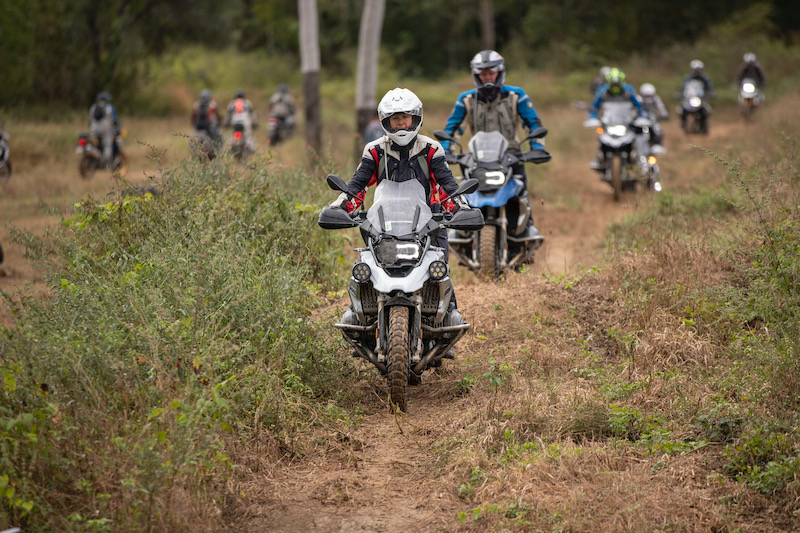It now seems so long ago, but May 2021 was a month of enormous distances traveled, diversity of landscapes and the feel of an entirely different climate. It began in the dry Red Centre of Australia and ended in the wet and green of Far North Queensland with one of the most memorable weeks of motorcycling I’ve experienced; the 2021 BMW GS Safari. (This link takes you to the official YouTube video of this event.)
After being immersed in the ancient wonders of the red centre at the end of April, I continued north to Alice Springs. The GPS then directed an eastward turn over the windswept, baron Barkly Tablelands to outback Queensland and the lush, warm and wet tropical coastline. Days and nights of incredible diversity, wonderful people and delicious food.
Travel along below for the highlights of this packed memorable month.
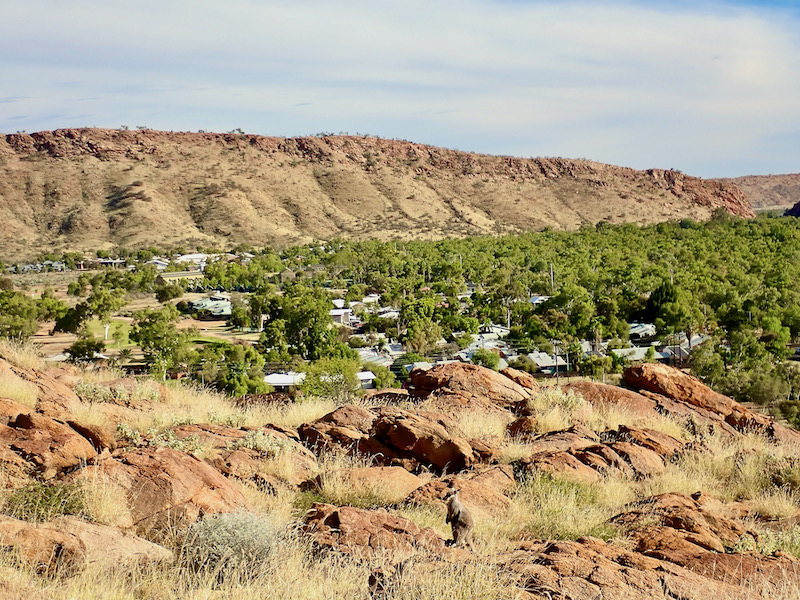
ALICE SPRINGS, NORTHERN TERRITORY: The most surprising aspect of Alice Springs is that it’s not entirely on flat country. Situated on the most often dry Todd River, Alice Springs is surrounded by the Macdonnell Ranges and is located at almost the exact same distance from Adelaide as it is from Darwin. Servicing a huge geographical area, its indigenous and non-indienous population of around 25,000 is incredibly diverse with many being itinerant workers in various fields and industries. As my stay coincided with a public holiday weekend, I spent a day with Adele; an anthropologist friend from WA now based Alice Springs, who had time to take me out on a special day trip.

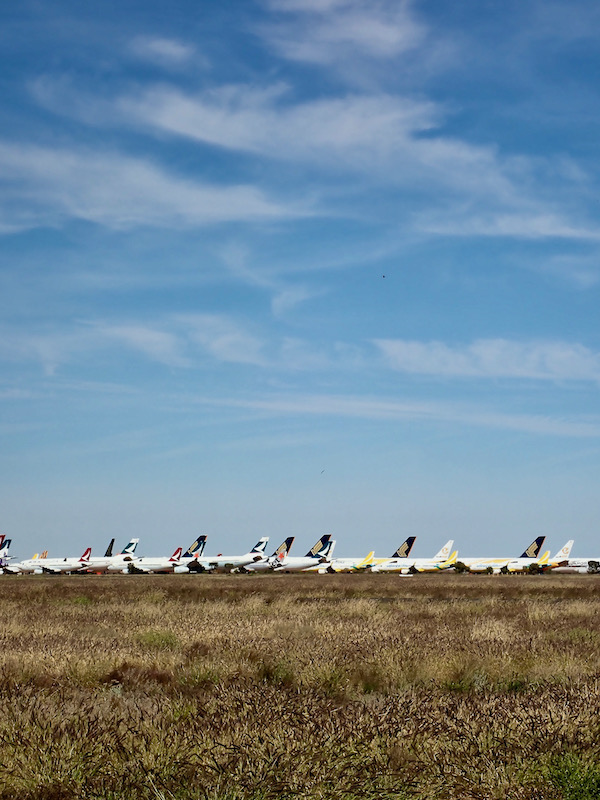
ASIA PACIFIC AIRCRAFT STORAGE: Looking like a flock of large stationary birds, we passed the surprising sight of a jumbo aircraft parking facility on our way to visit a nearby date farm. Due to the effect of Covid on the aviation industry and Alice Springs’ dry climate with cool nights, more than 100 planes are stored at this purpose-built facility adjacent to the airport. This facility provides specialised aircraft storage, maintenance and part-out services to the Asia Pacific aviation industry.
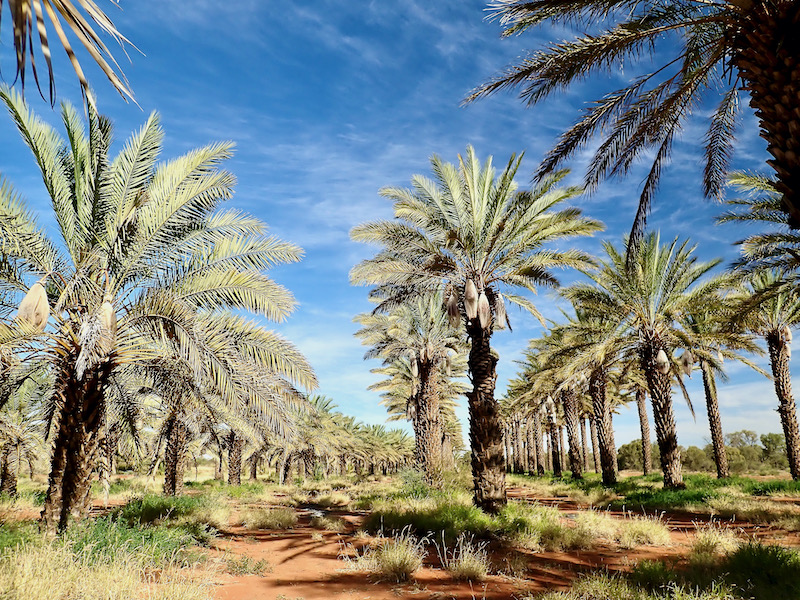
THE DESERT FRUIT COMPANY: The Desert Fruit Company is a cooperatively owned, worker run date farm located south east of Alice Springs just shy of the edge of the Simpson Desert. Tamara Plantation was established in 1991 by Jim and Trudi Luedi. Since 2014, the farm has been managed by members of the Tamara Co-operative. Workers receive an hourly wage for their labour with any profits being re-invested into the farm to create a sustainable business.


Undistracted by catch-up chat and laughs, Adele’s experienced sand dune driving skills meant an easy, soft journey aided by directions artistically painted on a car bonnet sign. On arrival we were met by Kim Mackay who is one of the Tamara Co-operative members and resident date farm manager. Adele had met Kim via the Alice Springs Community Garden. Kim’s extensive knowledge of plant species and food growing was clearly evident in the abundant sprawling vegie garden, which we wandered through, chatted about and picked from for a delicious lunch.

The Desert Fruit Company produces 12 different varieties of dates, many of which are very soft when harvested that need semi-dehydrating prior to packaging and distribution. Sold to markets predominately in the eastern states, the dates are also exported to the Middle East.


The Medjool variety most commonly known is on the left. Originating from Morocco, the flavour is sweet, mildly rich and smooth and the fruit is deep brown, moderately wrinkled and translucent. The dates on the right are the Barhee (rutab). Originally from Basra, Iraq, rutab barhee are round, translucent and soft with a mellow honey-caramel flavour. The skin is slightly papery and separates from the flesh as they dry.



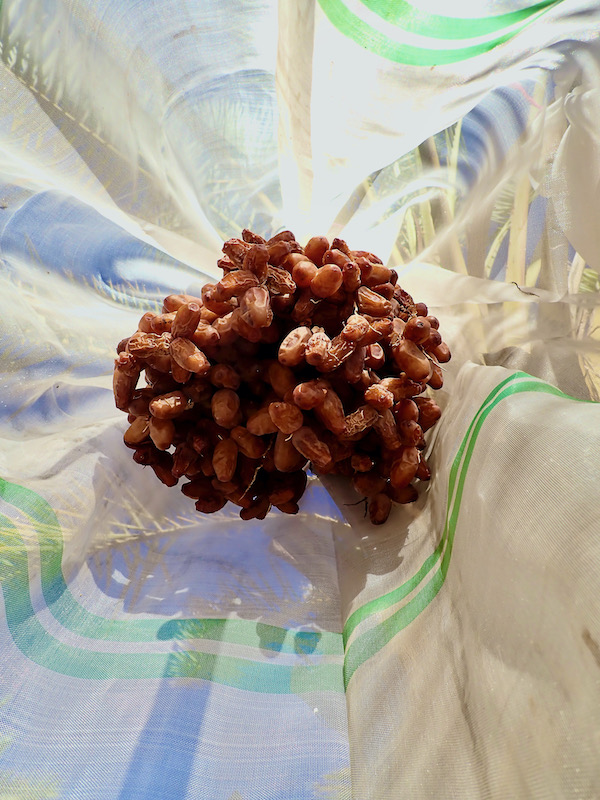
Special bags are fastened over the bunches of dates at the end of the fronds to catch the fruit as they ripen and fall. These bags are then collected with the use of a cherry picker machine.


Kim’s knowledge and experience has not only been about growing food but also the cooking as a chef in years past. Our delicious lunch was prepared from produce grown and processed on the farm, including homemade sausages and fresh chicken liver.


Prior to Covid, WOOFERS (World Wide Opportunities on Organic Farms) workers and backpackers were part of the labour mix. This quirky gypsy caravan with key-hole view of the date palms being part of the visitor and worker accommodation on the farm.
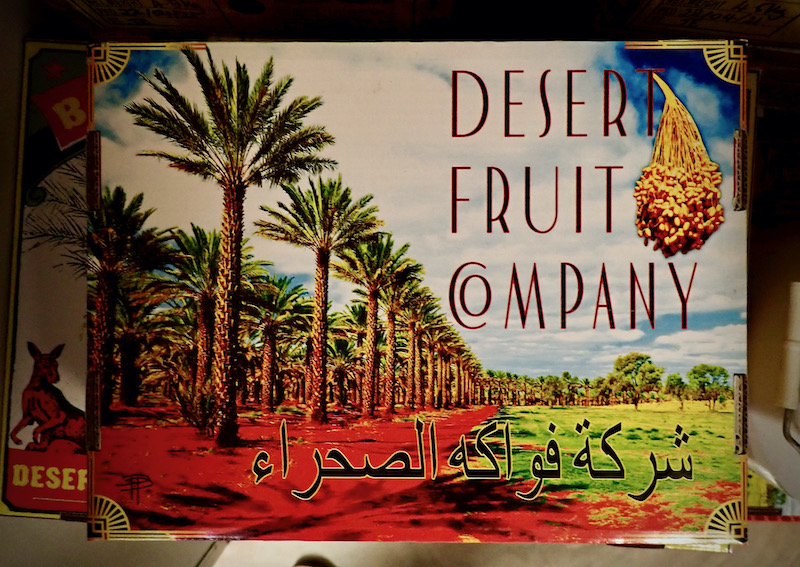
Local artists are seasonally commissioned to design the artwork for the boxes in which the dates are sold; this one created by well-known Northern Territory artist Pip McManus.

HERMANNSBERG HISTORIC PRECINCT, NTARIA [HERMANNSBERG]: Growing up in the Barossa Valley with a strong heritage of the Lutheran Church, I’ve long been aware of Hermannsberg. Based at the remote foothills of the MacDonnell Ranges, 130 kilometres west of Alice Springs, the Hermannsburg Mission was established in 1877. It was managed by Lutheran missionaries and the Lutheran Church from 1877-1982 and is the last surviving mission developed by missionaries from the Hermannsburg Missionary Society in Germany under the influence of the German Lutheran community in South Australia. The mission functioned as a refuge for Aboriginal people during the violent frontier conflict of early pastoral settlement in Central Australia. The Lutheran missionaries were independent and outspoken, playing a key role in attempting to mediate conflict between pastoralists, the police and Aboriginal people, and speaking publicly about the violence, sparking heated national debate.

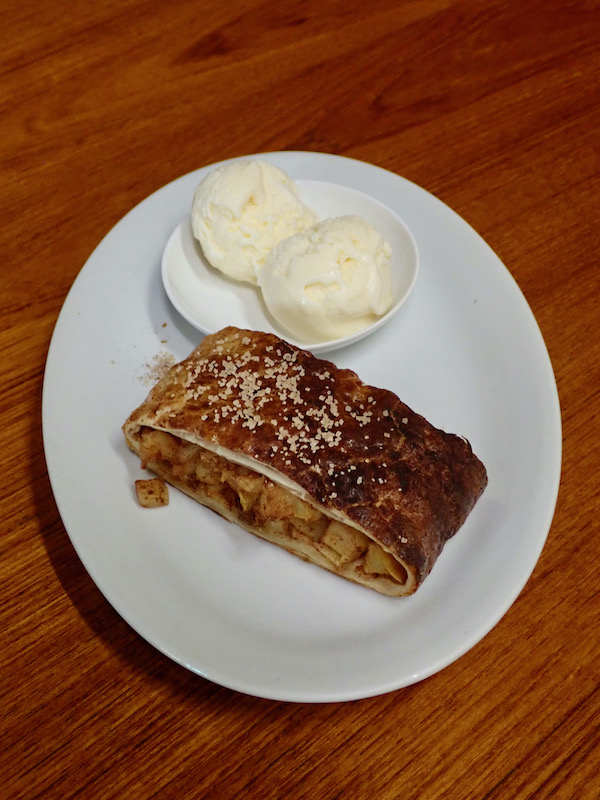
Hermannsburg Historic Precinct is a nationally listed heritage site that is owned by the Western Arrarnta people and managed collaboratively with them by Finke River Mission under the direction of the Hermannsburg Historical Society. The Precinct includes the physical remains of the Finke River Mission Station, otherwise known as Hermannsburg Mission. There are many interesting historical buildings to poke around in after which I gravitated to the Kata Anga Tea Rooms in Strehlow’s House and enjoyed a morning tea of their now famous apple strudel.


The stories of Hermannsberg are many: A mission that operated for 150 years, a people that owned this country for millennia, foreign colonists under resourced and struggling in the harsh Australian outback, a history of frontier violence and sanctuary, years of drought and illness and heartbreak, enduring friendships and a community that continues to grow and evolve in response to the changes in the world around them.
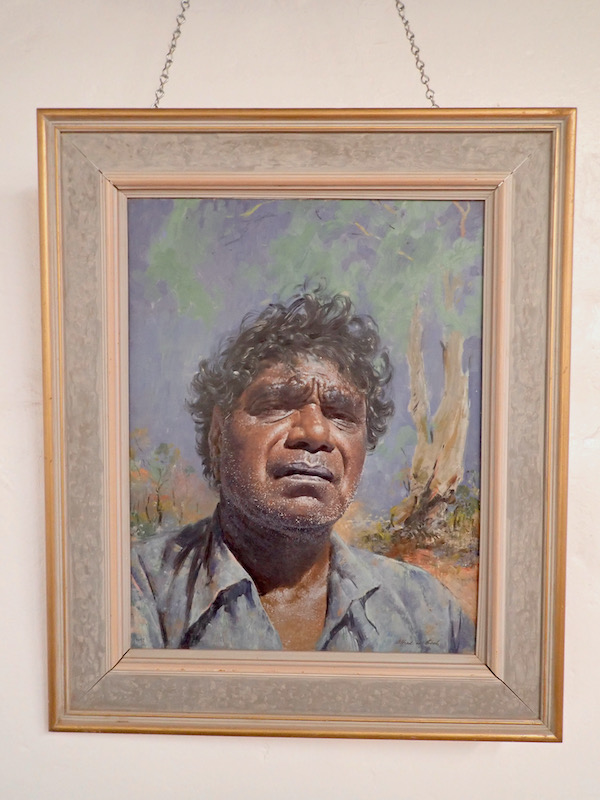

ALBERT NAMATJIRA: Albert Namatjira is one of Australia’s best-known artists. His richly detailed, Western art-influenced watercolours of the outback departed significantly from the abstract designs and symbols of traditional Aboriginal art, and inspired the Hermannsburg School of painting. Belonging to the Western Arrernte people, Namatjira was born in 1902 and was raised at the Hermannsburg Lutheran Mission. Not far from the Hermannsburg Historic Precinct is a small house that Namatjira built for himself and his family in 1944. Despite it now being empty, the house is significant for its associations with the man who gained national and international fame. That fame and its many obligations eventually took its toll on his health and life, however his works remain a vital part of the heritage of the Northern Territory and Australia.

Although not the first Aboriginal artist to work in a European style, Albert Namatjira’s skills in European watercolour painting were interpreted as evidence of the potential success of assimilation policies. The Araluen Arts Centre in Alice Springs holds a comprehensive collection of artworks by Albert Namatjira that span his career as well a large collection of works from the Hermannsburg School including Namatjira’s contemporaries, his sons and grandchildren and artists who continue the watercolour tradition today. These works provide an extensive catalogue of this important movement. The above painting is West Macdonnells, Central Australia by Edwin Pareroultja.
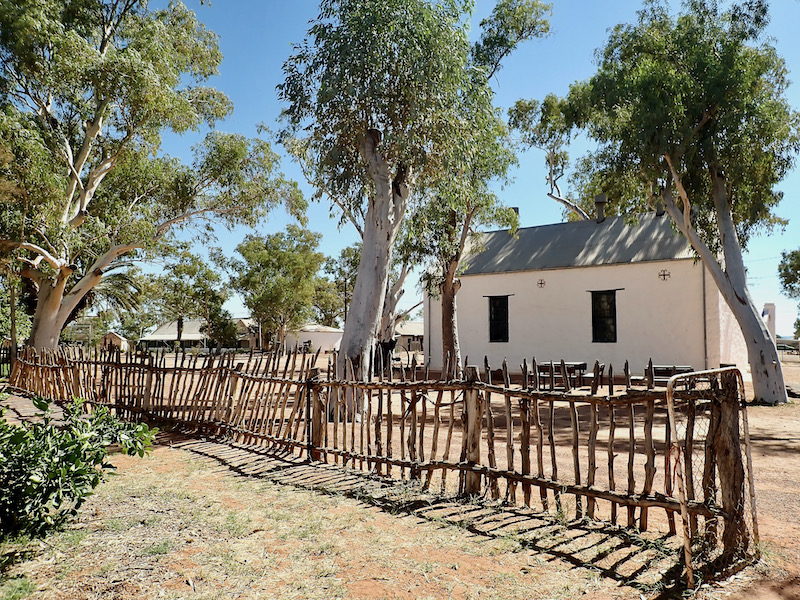
‘Our Elders live on in us – the younger generation. We look after the old mission because it is part of our past, but it is also part of our future. We hope that tourism will help us build a sustainable community’. (Nicholas Williams 2019)


HERMANNSBERG POTTERS: The Hermannsburg Potters are an Aboriginal Corporation based in Hermannsberg (Ntaria) that bring the vibrant landscape and spirit of Central Australia to life with their hand-crafted terracotta and underglaze pots. Taking inspiration from Country, culture, history and day to day life activities the Potters depict family, birds, animals, bush tucker, mission days, stories of Country and current life in Hermannsburg (Ntaria) . ‘Aranda people like to learn and work in new things. My grandmother learnt to crcohet for the church, my uncles learnt watercolour painting, my grandmother was Albert Namatijira’s half sister. And now, in this gereration, we are first in pottery and traveling the world’ – Clara Ngal Inkamala. Unfortunately their studio was closed when I visited but the above pots were displayed at both the Historic Precinct and the Araluen Arts Centre in Alice Springs.
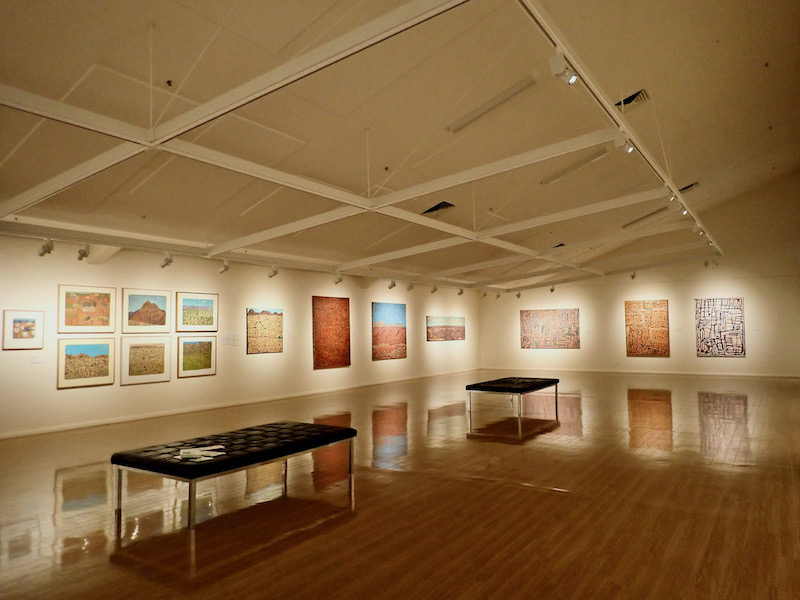
ARALUEN ARTS CENTRE, ALICE SPRINGS: The Araluen Arts Centre operates as the visual art and performance hub of Central Australia, presenting an annual program of exhibitions, performances, and film. Known as the keeping place of stories, Araluen holds within its spaces some of the most significant works of art in Central Australia and brings to the stage world class performances from around the nation (and at times the world).
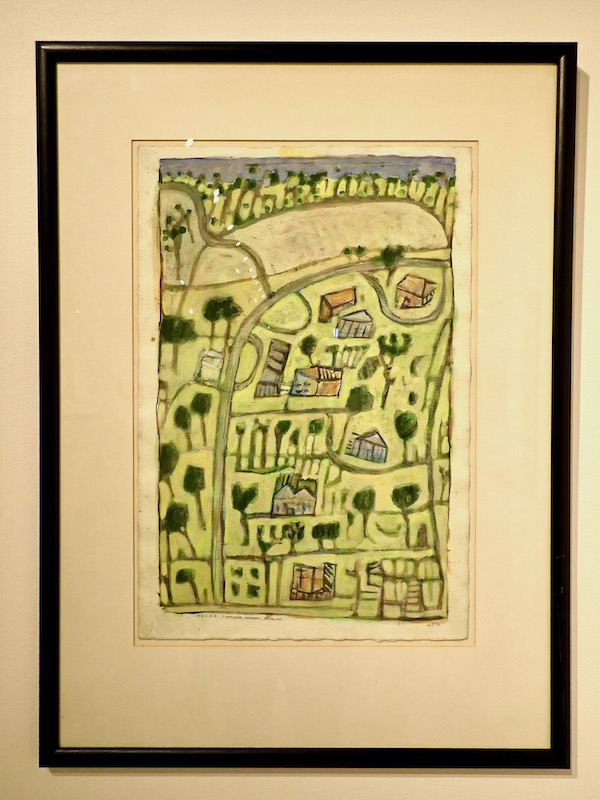

CSIRO Compound, Naramu. 1990 Gouache on paper. Wayne Eager.
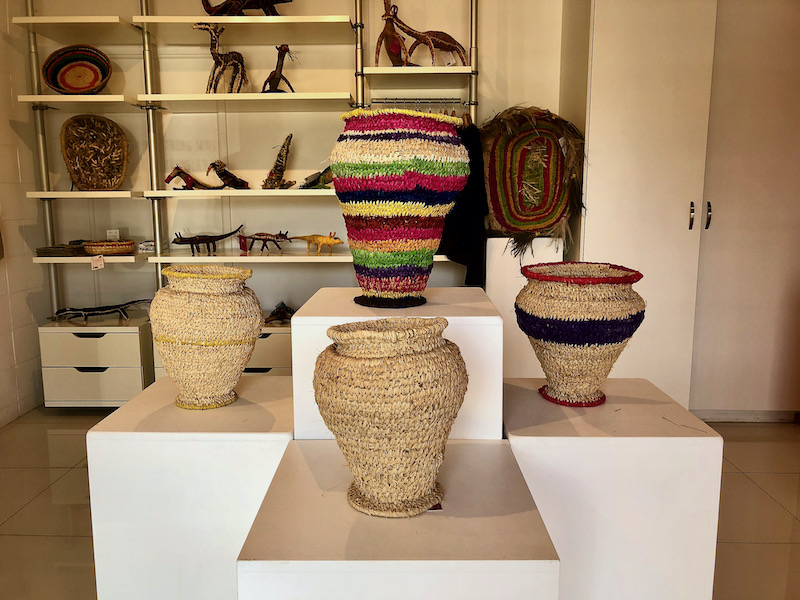
TJANPI DESERT WEAVERS, ALICE SPRINGS: Tjanpi Desert Weavers is a social enterprise of the Ngaanyatjarra Pitjantjatjara Yankunytjatjara (NPY) Women’s Council, working with women in the remote Central and Western desert regions who earn an income from contemporary fibre art. Tjanpi artists use native grasses to make beautiful contemporary fibre art, weaving beautiful baskets and sculptures that can be viewed and purchased online or at their small exhibition space / shop in Alice Springs.

ORMISTON GORGE, WEST MACDONNELL NATIONAL PARK: The spectacular Ormiston Gorge is a near-permanent waterhole located 135 kilometres west of Alice Springs in the West MacDonnell National Park. It showcases the spectacular geology and landforms of the MacDonnell Ranges and contains an interesting variety of native fauna and flora including a number of plant species from Central Australia’s tropical past.
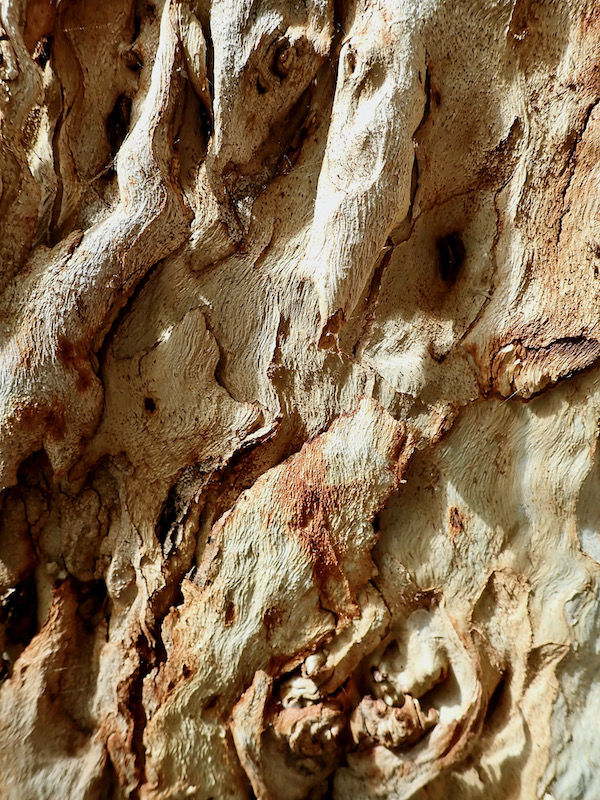

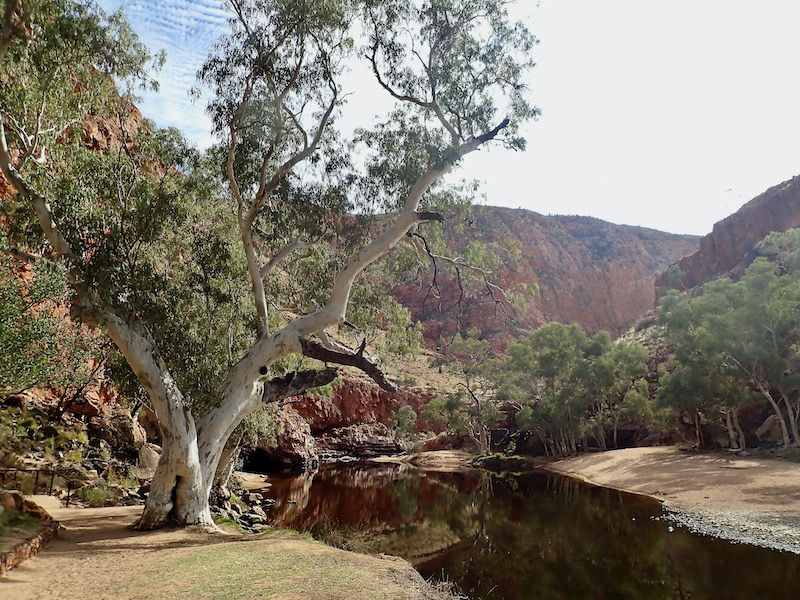
Ormiston Gorge and Pound covers nearly 5,000 hectares of the MacDonnell Ranges wilderness. This waterhole lies at the Southern end of the gorge and is a breeding ground and refuge for many native animal species including the stunning zebra finch.

THE OCHRE PITS, WEST MACDONNELL NATIONAL PARK: On my way back to Alice Springs from Ormiston Gorge, I stopped at the Ochre Pits. Aboriginal people have extracted ochre from these pits for thousands of years, which are still used by the Western Arande people for mostly ceremonial purposes.


Ochre occurs in a range of earthy colours ranging from white, yellow, orange, red and browns and used for paintings and ceremonial body decoration. Weapons were also painted with ochre to increase the success of hunting and to protect the wooden weapons from termites. Red ochre was mixed into an ointment to relieve decongestion, and white ochre used as a magical charm.

KARLU KARLU [DEVILS MARBLES], TENNANT CREEK: From Alice Springs I continued riding north to Tennant Creek, stopping at the Devils Marbles along the way. The Devils Marbles are a sacred site known as Karlu Karlu in the language of the traditional owners the Warumungu people.
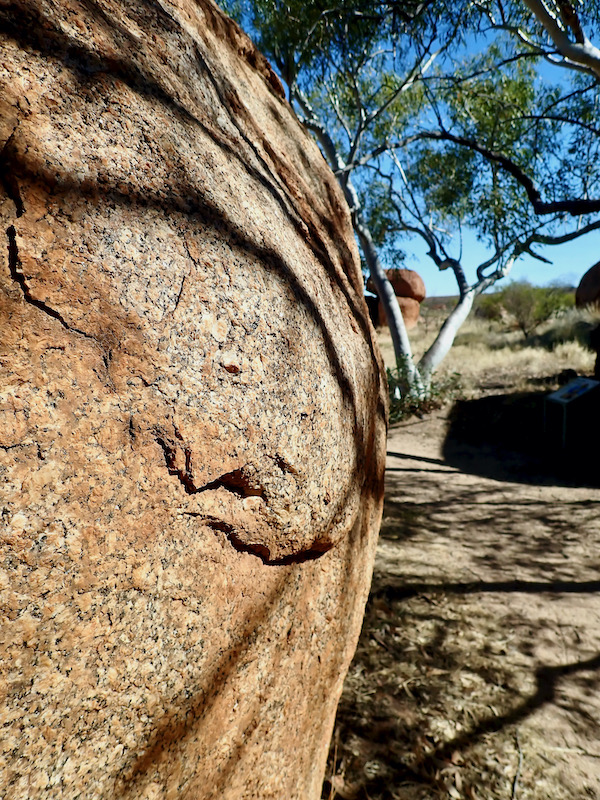

Formed over millions of years, they continue to crack and erode. The marbles are remnants of a solid mass of granite, the bulk of which still lies underneath them. Water filtering into the outer layers of the boulders causes flakes of granite to peel away creating onion-skin like weathering.
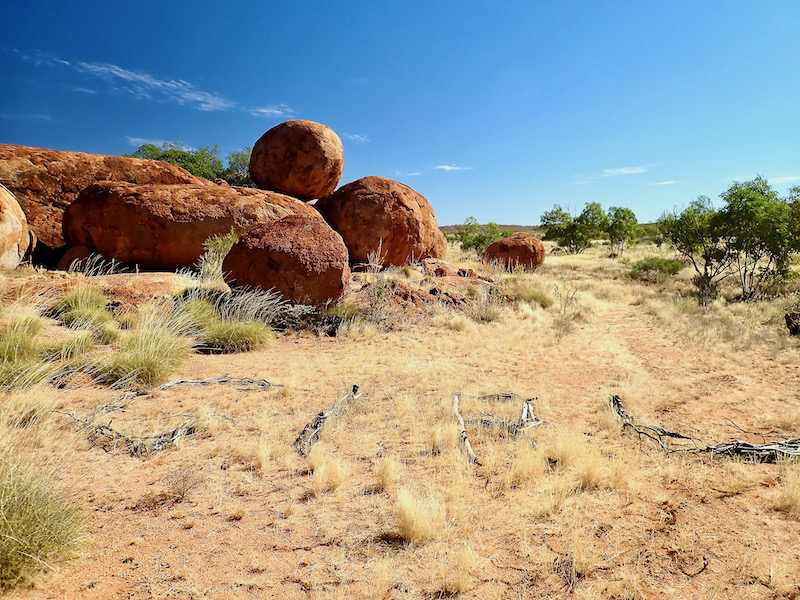
While walking around the boulders I noticed sticks arranged on the ground spelling out the word GIRL. Perhaps a birth announcement for relatives and friends flying above?

CLONCURRY, QUEENSLAND: After crossing the arid Barkly Tablelands, I spent a night in Cloncurry (130km east of Mount Isa), which began with a most spectacular sunset. Outback sunsets are truly stunning and a wonderful reward for hours of passing through barren landscapes baking in the hot sun.

THE AUSTRALIAN STOCKMAN’S HALL OF FAME & OUTBACK HERITAGE CENTRE, LONGREACH, QUEENSLAND: From Cloncurry it was on to Longreach where I visited The Australian Stockman’s Hall of Fame & Outback Heritage Centre. The Centre’s five themed galleries display the history behind some of Australia’s greatest explorers, stock workers, pastoralist, and Aborigines. The exhibits are a mix of objects, images, touch screens, audiovisual presentations and open displays, allowing visitors to interpret the outback story in their own unique way.


The founder of the Hall of Fame was artist Hugh Sawrey, a well-known painter and former stockman. His vision was to create a memorial to the explorers, overlanders, pioneers and settlers of outback Australia. This dream was shared by other outstanding Australians, including the legendary R. M. Williams.
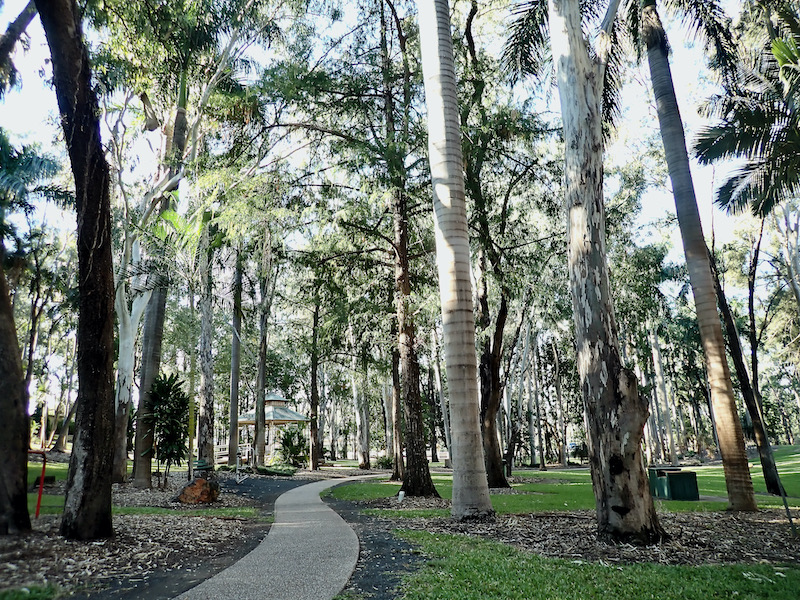
EMERALD, QUEENSLAND: Following hundreds of kilometres in the outback, the red dirt quickly disappeared, the air suddenly turned humid and I arrived in the Central Highlands Regional town of Emerald. Located approximately 10km south of the Tropic of Capricorn, the town takes its name from the emerald and other precious stones found in the area. Needing a couple of days rest, time to wash clothes and post now unnecessary winter layers back to Fremantle, I booked a self-contained cabin in the town centre, nearby to the Emerald Botanical Gardens.
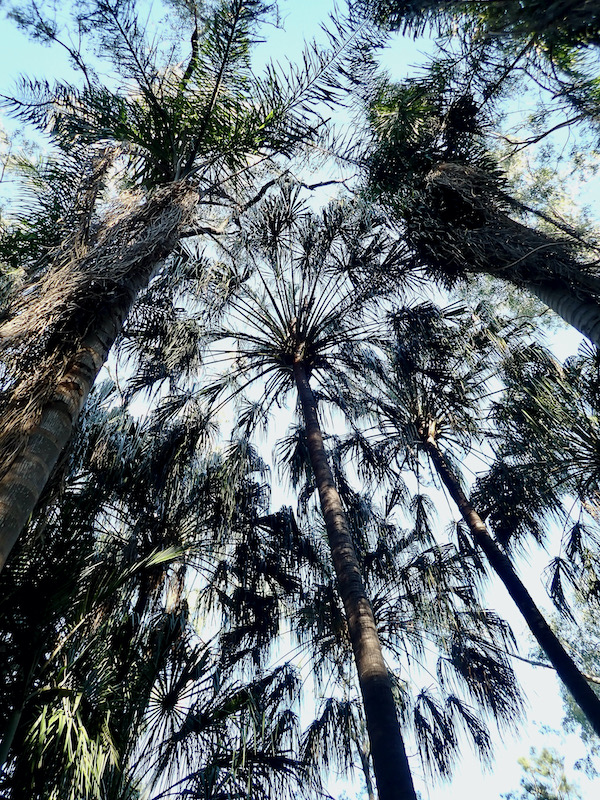
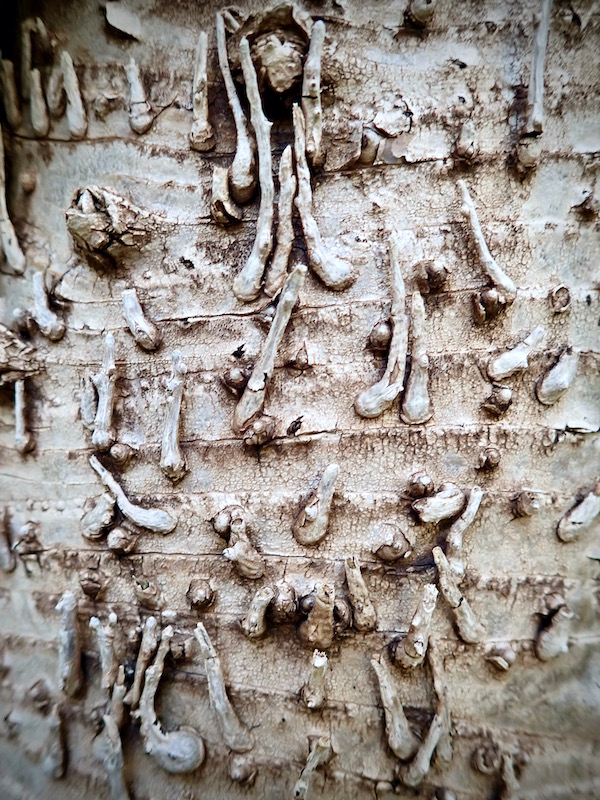
Established in 1987, covering an area of 42 hectares and situated on the banks of the Nogoa River, the Emerald Botanic Gardens are the only botanic gardens located within the Central Western District of Queensland and are home to 12 different themed plant communities; representing plant species that are native to the region.

BLACKS BEACH, MACKAY: From Emerald I continued east to the capital city of Australian beef, Rockhampton and then up the coast to pitch my tent on a campground at Blacks Beach. Located at Mackay’s Northern Beaches, Blacks Beach is Mackay’s longest continuous beach, approximately six kilometres in length from which you can see the southern islands of the Whitsundays. A stunning early morning walk.


Stains, paw prints and crusty rock surfaces that caught my eye along this beautiful beach.
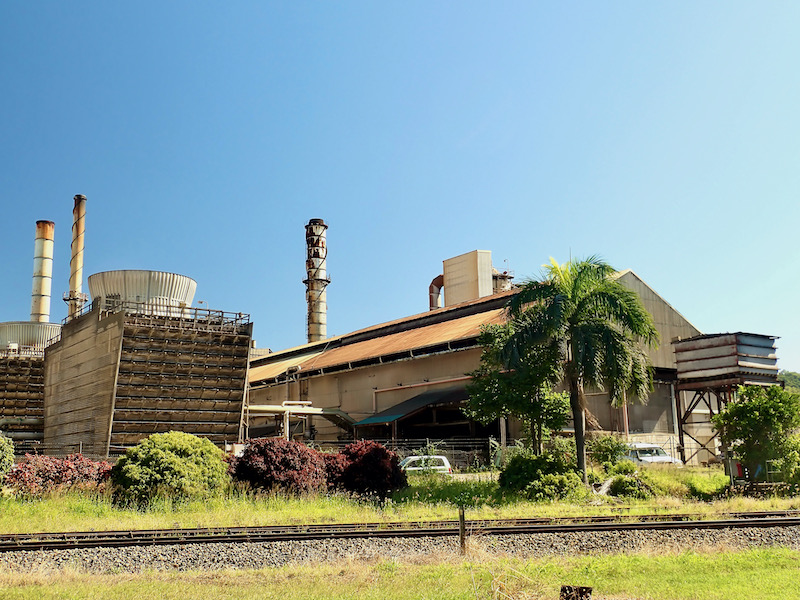
SARINA SUGAR MILL & SHED, SARINA: Just over 30 km south of Mackay is a the sugar cane growing and milling town of Sarina. Here I took a short tour at the Sarina Sugar Shed, which showcases the rich heritage of sugar cane farming in Queensland and goes through how sugar cane is planted, cut, milled and processed. Including a taste of freshly squeezed cane juice, which unsurprisingly tasted faintly grassy and mildly sweet.


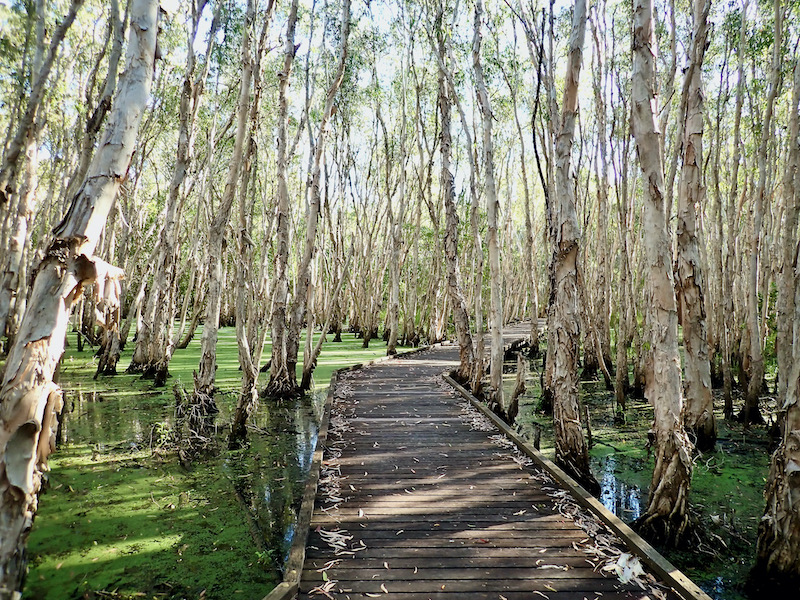
THE KOMMO TOERA TRAIL, MACKAY: Away from the beautiful beaches I decided to walk The Kommo Toera Trail, located in melaleuca rainforest in the Port of Mackay conservation area. The trail is a 1 km boardwalk system traversing almost every habitat found in this coastal environment. Paperbarks are the dominant trees along the trail. The characteristic white to pale brown paperback, often blackened by fire is one of the few trees that can survive in knee-deep water. Just don’t forget personal insect repellent. The mosquitos were epic!

THE PIONEER VALLEY, EUNGELLA: On another day, I decided to take a ride through The Pioneer Valley and up the fun, steep, twisty 4.5 km road through the Eungella Range to have lunch at the Eungella Chalet. Built in 1933 as a guest house for people requiring clear mountain air, the Eungella Chalet has been a landmark in the local area for decades. The view from the grassed and deck area over the luminescent green sugar cane field dotted Pioneer Valley was breathtaking and where hang-gliders regularly launch.


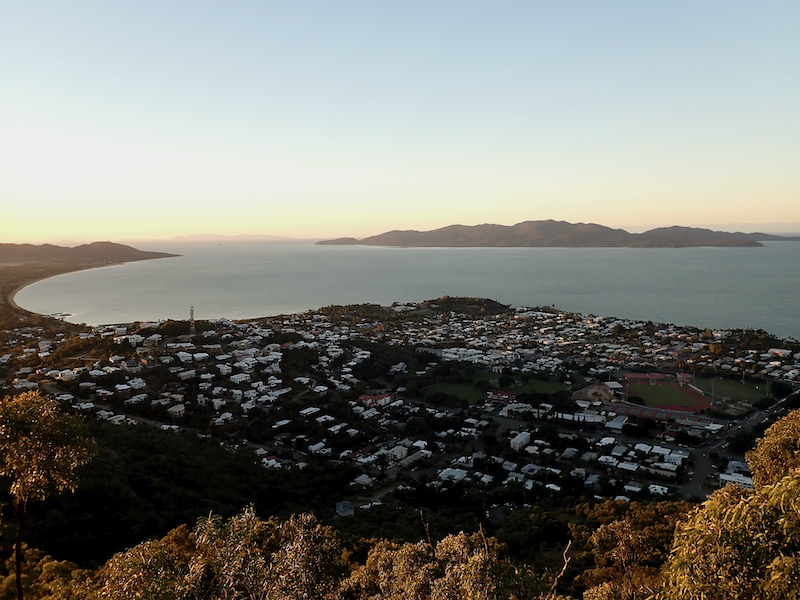
TOWNSVILLE, QUEENSLAND: From Mackay, I made my way further up the coast to Townsville. Arriving a few days prior to the start of the BMW Safari Tour meant having some time to explore this central Far North Queensland city; located in the dry tropics region of Queensland and adjacent to the central section of the Great Barrier Reef. This late afternoon view is from atop Castle Hill; a massive pink granite rock that dominates Townsville’s skyline.

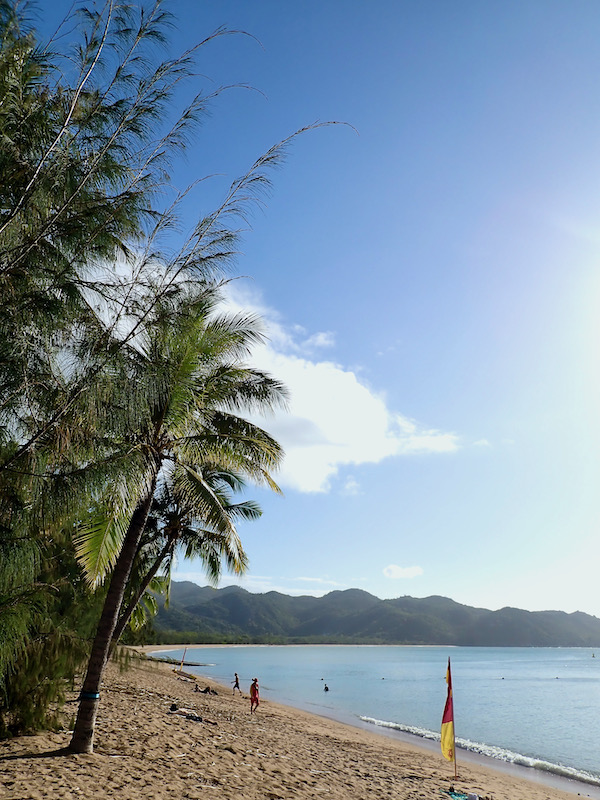
MAGNETIC ISLAND, QUEENSLAND: Situated 8km offshore from Townsville is Magnetic Island; a terrific day trip. Along with being a popular holiday location, ‘Maggie’ as it’s fondly called by the locals has effectively become another suburb of Townsville.
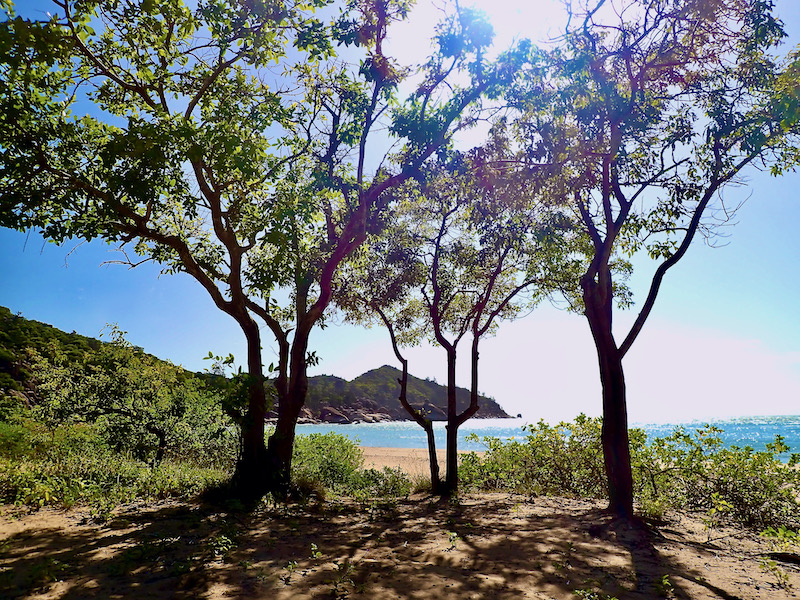
Unfortunately the main walking trail on the island called The Forts was closed for restoration work, however via Horseshoe Bay the walk to Radical Bay that climbs through a steep gully and forest to a ridge with open eucalyptus woodland didn’t disappoint. This beautiful north facing beach is surrounded by majestic hoop-pines and boulder-strewn headlands.


BILLABONG SANCTUARY, TOWNSVILLE: Despite avoiding popular places for school groups and generally preferring to see animals in the wild, I took the time to visit Billabong Sanctuary. Located 17km south of Townsville, the founder’s priority focus was conservation education by establishing natural habitats for a variety of native animals. Spread among several enclosures in the park, Billabong Sanctuary has a healthy breeding population of Koalas. This fella captured mid-yawn. On the left, a Cassowary. The southern cassowary is Australia’s heaviest flightless bird with dagger-like talons that’s habitat is in far north Queensland. It was interesting to see this living dinosaur prior to the motorcycle tour as we passed many roadside signs asking motorists to take care if sighting this shy but potentially very dangerous bird.
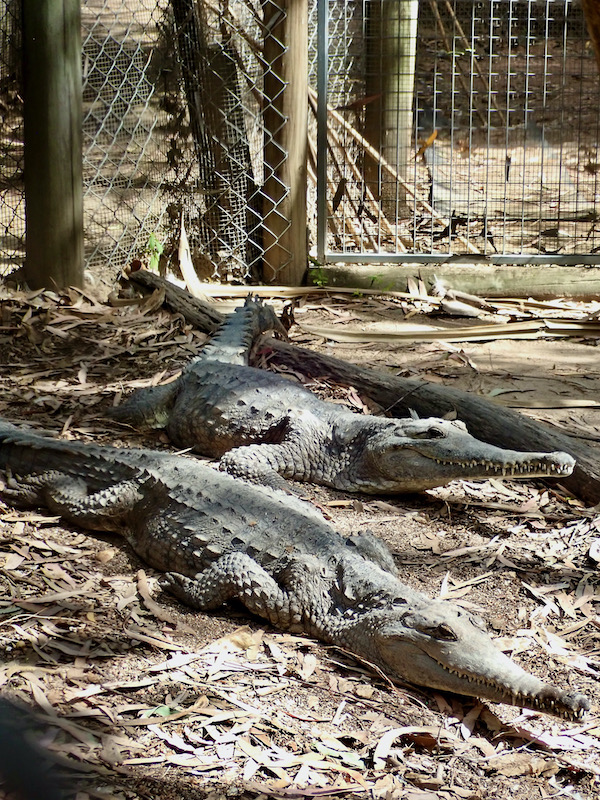
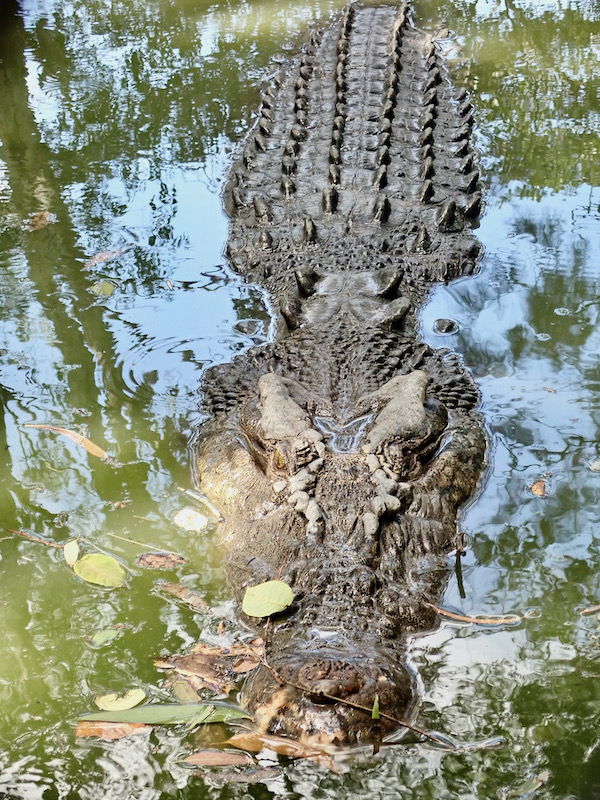
One of a few animals I’m happier to see in captivity than up close in the wild are crocs. Australia is home to two species of crocodiles, the Estuarine Crocodile (commonly called Salty’s) and the Freshwater Crocodile. They’re found throughout the northern coastal fringe and adjacent rivers, anywhere north of about Rockhampton in Queensland, all around the coast of the Northern Territory and as far south as Broome in Western Australia.

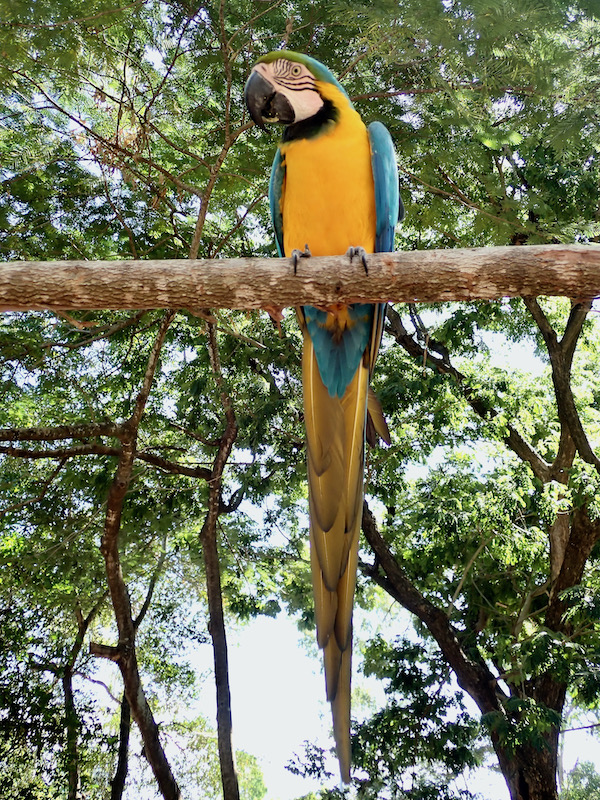
Billabong offers an afternoon Feathered Friends show including Skwimm, a beautiful, gentle tawny frogmouth. On the right a less gentle and much louder, bolshy blue and yellow imported macaw.

BMW MOTORRAD AUSTRALIA | 2021 BMW GS SAFARI, TOWNSVILLE TO CAIRNS: And then finally it was time. For those of us bitten by the GS (“Gelände/Straße” The German words for off-road/road) motorcycle bug, the sight of 200 BMW 1200 and 1250 GS adventure bikes is an adrenaline-heart-pumping thing. Bikes and brands are tribal and after traveling solo for a long time, it felt a little like rejoining a long lost family of sorts. Sharing this first Safari with the friend from the Barossa that ignited the spark for motorcycle riding many years ago made this feeling even more so. The above photo was the morning of Day1. Rhinos and excited riders preparing to be released.
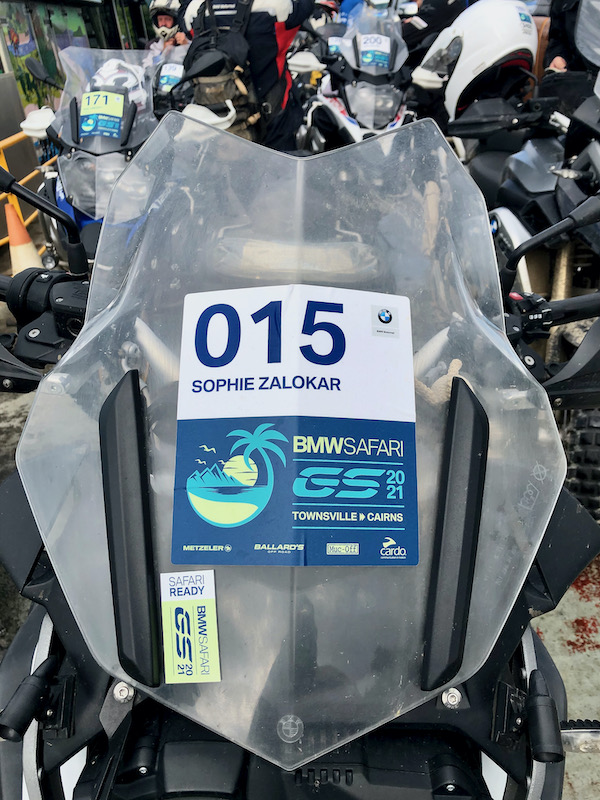


BMW Safaris generally run for 5 to 7 days as a point to point tour, but sometimes with the start and finish at the same location. It’s not a guided tour, the route is marked, route maps and GPS files are provided. With organised accommodation, meals, luggage, mechanical and medical support provided each day, riders go at their own pace and take in sights along the route. While some rides have been revisited and may be similar, no two rides have been the same in the 26 year history of the Safari. This makes every Safari a fantastic new adventure.
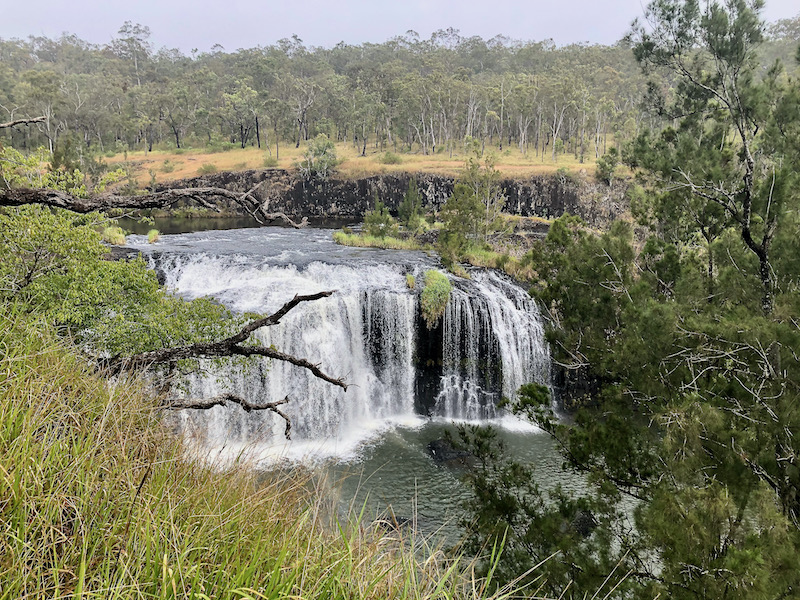
MILLSTREAM FALLS, MILLSTREAM FALLS NATIONAL PARK: One of the many scenic stops along the way was the Millstream Falls. In the rain shadow of the Great Dividing Range, plunging over the edge of a columnar basalt lava flow, Big Millstream Falls is reputedly the widest single-drop waterfall in Australia.

Here we’re lined up to catch the ferry across the Daintree River to Cape Tribulation and beyond; up the famous Bloomfield 4WD track to finish the morning’s ride for lunch at the historic Lion’s Den Hotel. The Bloomfield Track being famous for the number of challenging rocky water crossings, steep wet clay hills and rutted out twisty terrain.

HINCHENBROOK ISLAND: Located between Cardwell and Ingham on the Bruce Highway, we stopped for another great view, this time over Hichenbrook Island. The Island’s unique and diverse vegetation includes cloud-covered heaths, eucalypt woodlands, rainforest, wetlands and mangroves – habitat for a variety of wildlife. With so many rare plant communities and very restricted distribution of some species, Hinchinbrook Island National Park is considered to be a tropical lowlands of great importance.
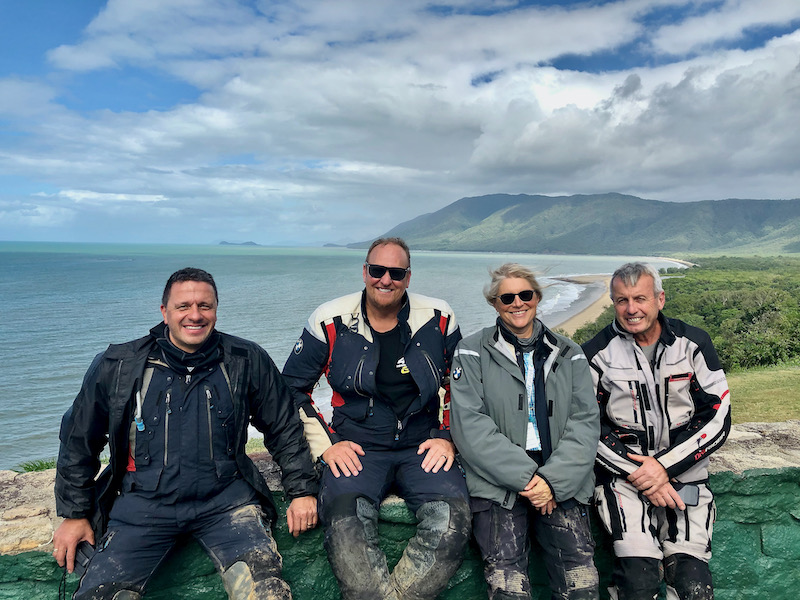
After a very muddy day, a few of us took a short break at the Rex Lookout on the Captain Cook Highway between Cairns and Port Douglas with a view over the Coral Sea. A launch location favoured by hang gliders.

CATHEDRAL FIG TREE, DANBULLA NATIONAL PARK & STATE FOREST: On the last day as we made our way through the Danbulla National Park & State Forest, we stopped at the Cathedral Fig Tree. This spectacular tree is a green fig. The elaborate strangling habit of this tree provides homes for a myriad of plants and animals which find their homes, beds and nesting sites in the roots and branches. This tree started out as a seed about the size of a sesame seed. No one knows the tree’s exact age but historical studies suggest it has been a part of this forest for around 500 years.
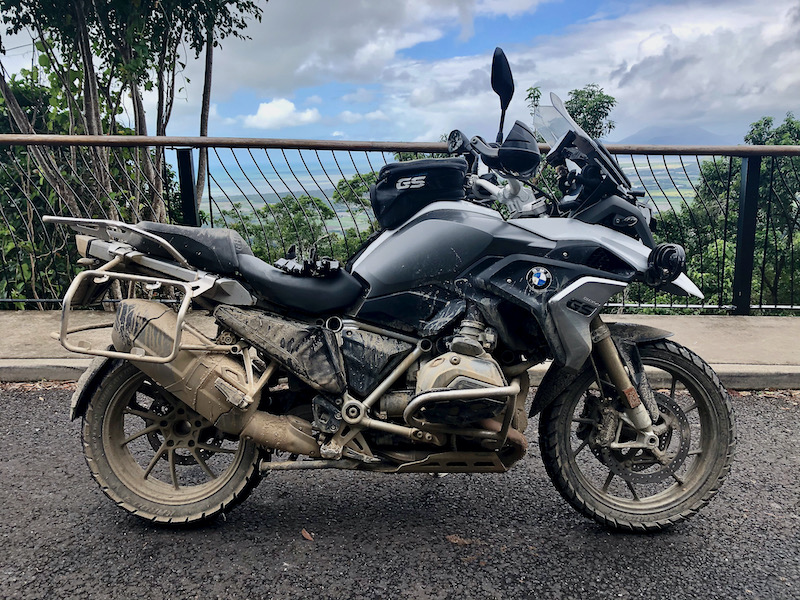
The dirtier the bike provides the proof of the enormous fun that was had! Following and being alongside far more experienced riders was a huge confidence building experience that took me to places on this tour I’d never anticipating reaching. With new friendships made and wonderful memories laid, I traveled on a high for days after this week ended. A wonderful life memory.


CAIRNS BOTANIC GARDEN: Before leaving Cairns, a visit to the Botanic Gardens, which is renowned as one of the best exhibitions of tropical plants in Australia was a lovely way to spend a few hours in this slice of paradise.

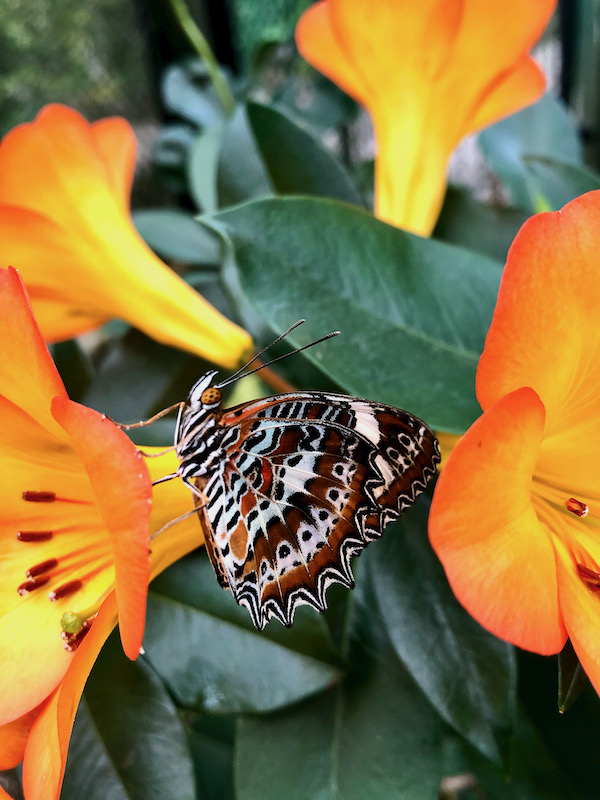
Inside the Flecker Garden is the Watkins Munro Martin Conservatory, which was built in 2015 to safely house and exhibit some of the Gardens’ most valuable and tender plants and a collection of beautiful local butterflies.


In the middle of Cairns CBD is Rusty’s Markets. Starting out in 1975, Rusty’s is now a Cairns tourist icon with over 180 stalls featuring exotic fruit (above are custard apples and persimmons), vegetables, and flowers, delis with fresh breads, dairy, and seafood, international food and beverage stalls, bric-a-brac, clothing, jewellery, coffee, chocolate etc. Even though the quality of the resort meals on the tour was of a generally good standard, it was great to be able to buy fresh produce in such an abundant region and cook again.

The above shot is of the sun rising over Palm Cove, which is situated between Cairns and Port Douglas. One of most beautiful locations we stayed at on the tour. Rather than a sunset at the end of this month’s blog post, it’s a beginning of the rest of the adventures ahead. Thanks for traveling alongside. Look forward to your company next month.

